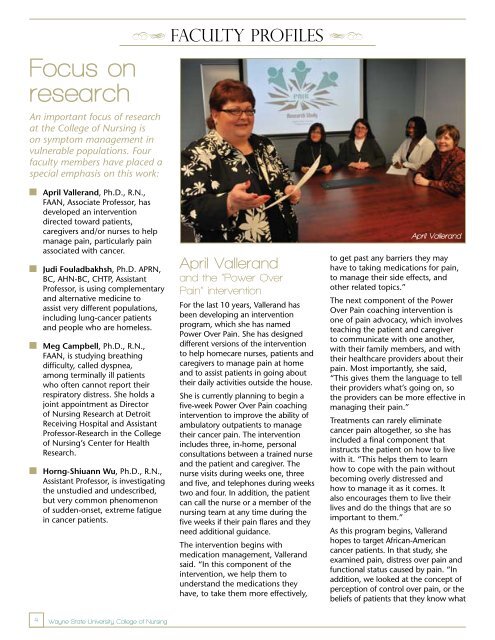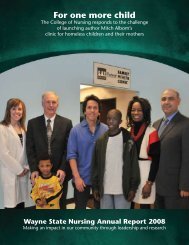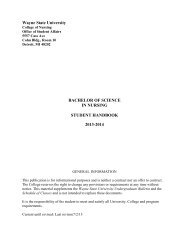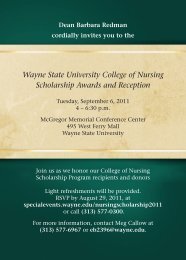The COLLEGE OF NURSING - Wayne State University
The COLLEGE OF NURSING - Wayne State University
The COLLEGE OF NURSING - Wayne State University
Create successful ePaper yourself
Turn your PDF publications into a flip-book with our unique Google optimized e-Paper software.
Ba FACULTY PR<strong>OF</strong>ILES AbFocus onresearchAn important focus of researchat the College of Nursing ison symptom management invulnerable populations. Fourfaculty members have placed aspecial emphasis on this work:n April Vallerand, Ph.D., R.N.,FAAN, Associate Professor, hasdeveloped an interventiondirected toward patients,caregivers and/or nurses to helpmanage pain, particularly painassociated with cancer.n Judi Fouladbakhsh, Ph.D. APRN,BC, AHN-BC, CHTP, AssistantProfessor, is using complementaryand alternative medicine toassist very different populations,including lung-cancer patientsand people who are homeless.n Meg Campbell, Ph.D., R.N.,FAAN, is studying breathingdifficulty, called dyspnea,among terminally ill patientswho often cannot report theirrespiratory distress. She holds ajoint appointment as Directorof Nursing Research at DetroitReceiving Hospital and AssistantProfessor-Research in the Collegeof Nursing’s Center for HealthResearch.n Horng-Shiuann Wu, Ph.D., R.N.,Assistant Professor, is investigatingthe unstudied and undescribed,but very common phenomenonof sudden-onset, extreme fatiguein cancer patients.April Vallerandand the “Power OverPain” interventionFor the last 10 years, Vallerand hasbeen developing an interventionprogram, which she has namedPower Over Pain. She has designeddifferent versions of the interventionto help homecare nurses, patients andcaregivers to manage pain at homeand to assist patients in going abouttheir daily activities outside the house.She is currently planning to begin afive-week Power Over Pain coachingintervention to improve the ability ofambulatory outpatients to managetheir cancer pain. <strong>The</strong> interventionincludes three, in-home, personalconsultations between a trained nurseand the patient and caregiver. <strong>The</strong>nurse visits during weeks one, threeand five, and telephones during weekstwo and four. In addition, the patientcan call the nurse or a member of thenursing team at any time during thefive weeks if their pain flares and theyneed additional guidance.<strong>The</strong> intervention begins withmedication management, Vallerandsaid. “In this component of theintervention, we help them tounderstand the medications theyhave, to take them more effectively,April Vallerandto get past any barriers they mayhave to taking medications for pain,to manage their side effects, andother related topics.”<strong>The</strong> next component of the PowerOver Pain coaching intervention isone of pain advocacy, which involvesteaching the patient and caregiverto communicate with one another,with their family members, and withtheir healthcare providers about theirpain. Most importantly, she said,“This gives them the language to telltheir providers what’s going on, sothe providers can be more effective inmanaging their pain.”Treatments can rarely eliminatecancer pain altogether, so she hasincluded a final component thatinstructs the patient on how to livewith it. “This helps them to learnhow to cope with the pain withoutbecoming overly distressed andhow to manage it as it comes. Italso encourages them to live theirlives and do the things that are soimportant to them.”As this program begins, Vallerandhopes to target African-Americancancer patients. In that study, sheexamined pain, distress over pain andfunctional status caused by pain. “Inaddition, we looked at the concept ofperception of control over pain, or thebeliefs of patients that they know what4 <strong>Wayne</strong> <strong>State</strong> <strong>University</strong> College of Nursing






